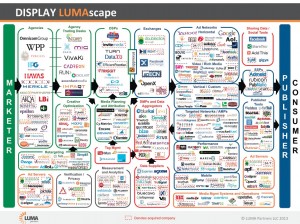There are quite a few Supply Side Platforms on the market. What product features would make a new one stand out? Or just name the most important features of an SSP solution, please.
This question was asked on Quora.com, below is my answer.
 The primary customer of the Supply Side Platform is the publisher. Most features are geared toward publisher needs. Access to demand is the paramount feature. Maximizing publisher yield over the long-term is also critically important. Companies that were already yield optimizers have taken the lead in the online display SSP space.
The primary customer of the Supply Side Platform is the publisher. Most features are geared toward publisher needs. Access to demand is the paramount feature. Maximizing publisher yield over the long-term is also critically important. Companies that were already yield optimizers have taken the lead in the online display SSP space.
Additional features found in the top-shelf SSPs are reporting insights into the demand (i.e. who’s buying the inventory) as well as incorporating pricing intelligence into audience segments (i.e. what are my users worth). Armed with these two tools, a publisher is empowered to make more informed direct sales.
In fact, some SSPs are building utilities so support those direct sales efforts via the RTB protocol. This is being referred to in the industry as “programmatic trading” or “programmatic buying and selling”.
I think these are all stand out features of SSPs. Then there’s the one that doesn’t get mentioned too much: scale. Scale is probably the toughest challenge a Supply Side Platform will face. Consider that a killer feature, as well.



 In a typical RTB transaction there’s a user ID, pulled from the user’s cookie or some form of server side system, which is passed to the DSP from the SSP. That ID is, in most cases, the DSPs record locator for the user’s information. Most DSPs have a server side data store where this information is housed, updated and augmented from a variety of sources including data companies like Blue Kai and Excelate and their ilk. DSPs may also be collecting and distilling information based on bid request activity from that user (although most SSPs put language into the contracts governing the use of this “bid stream” data) or retargeting data gathered for their customers. This type of data system is generally referred to as a Data Management Platform (DMP) in the industry. While there are some stand-alone DMPs out there, more and more DSPs are integrating or building their own.
In a typical RTB transaction there’s a user ID, pulled from the user’s cookie or some form of server side system, which is passed to the DSP from the SSP. That ID is, in most cases, the DSPs record locator for the user’s information. Most DSPs have a server side data store where this information is housed, updated and augmented from a variety of sources including data companies like Blue Kai and Excelate and their ilk. DSPs may also be collecting and distilling information based on bid request activity from that user (although most SSPs put language into the contracts governing the use of this “bid stream” data) or retargeting data gathered for their customers. This type of data system is generally referred to as a Data Management Platform (DMP) in the industry. While there are some stand-alone DMPs out there, more and more DSPs are integrating or building their own.


